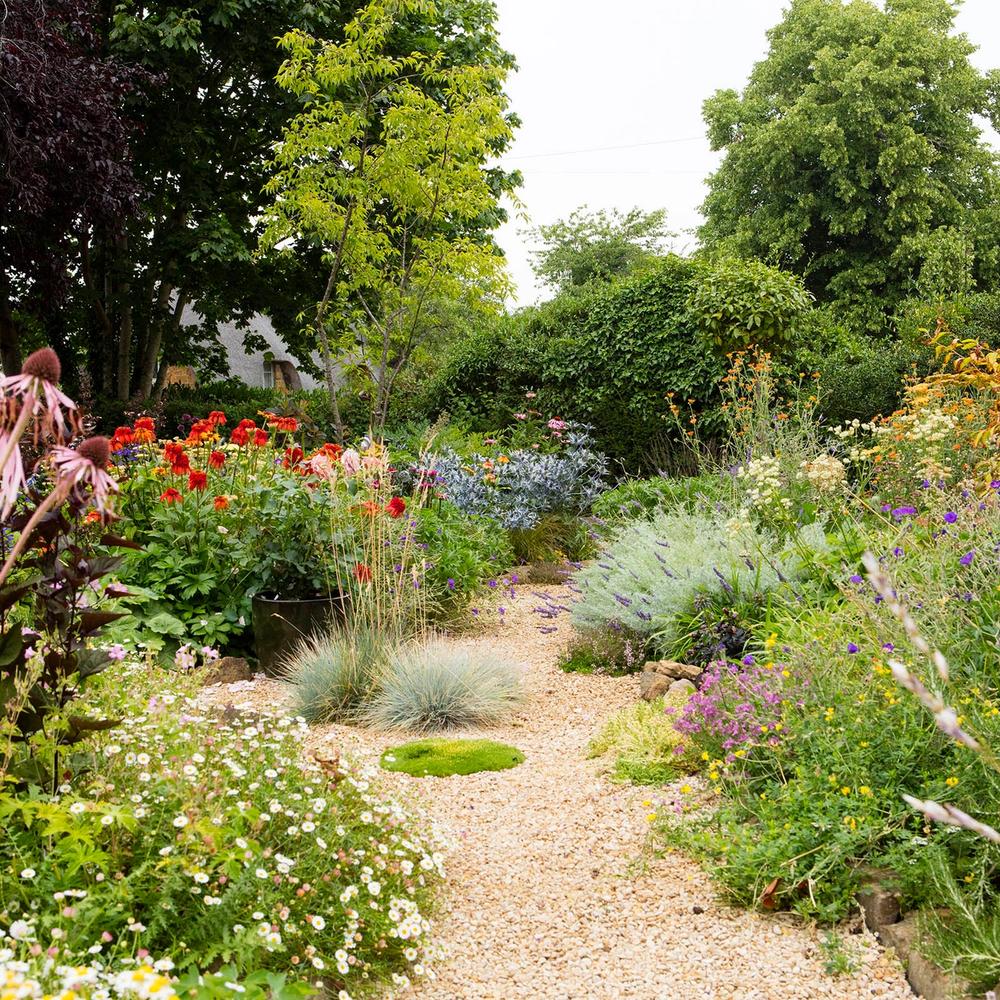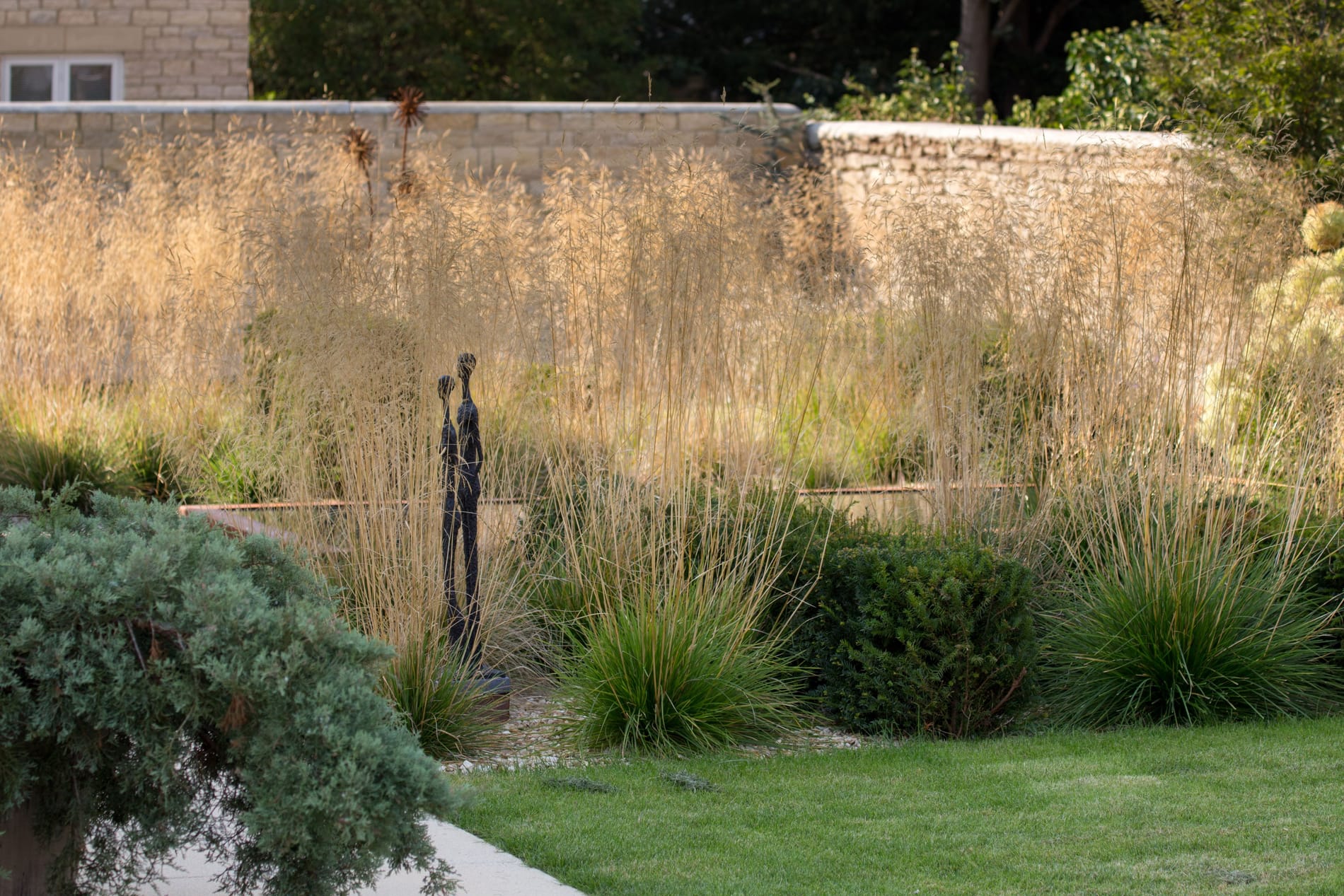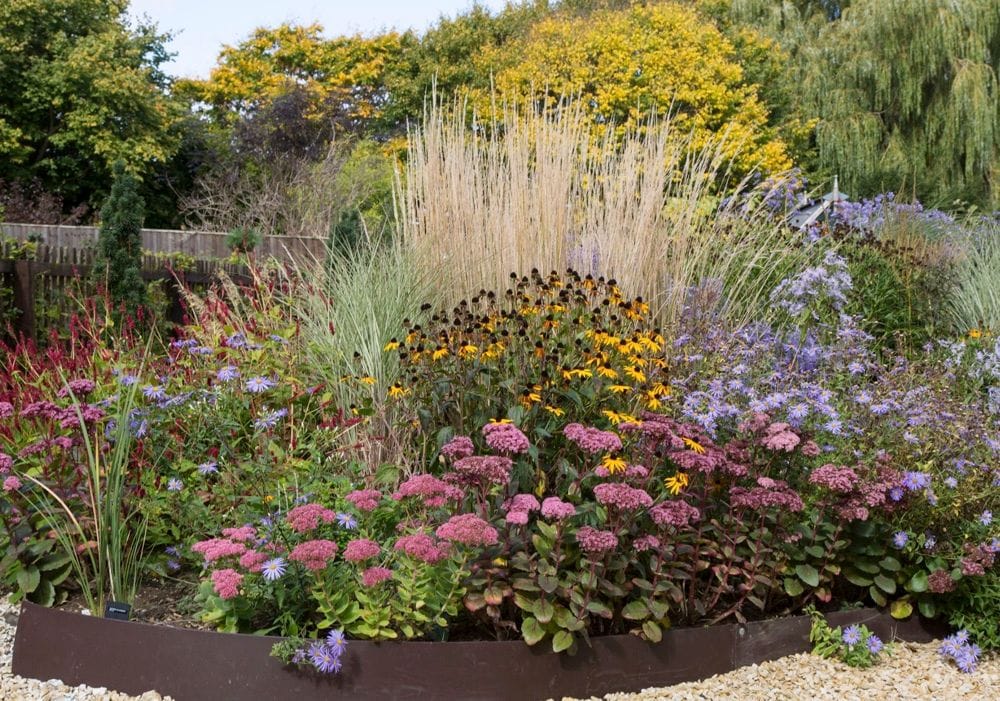
Drought Tolerant Plants By Oxford Garden Designs

After the long, hot, dry spring and summer the impact of climate change in most of our gardens is obvious. Establishing that pristine, green stripy lawn has been a challenge this summer, and, given the shortage of water in our reservoirs, not sustainable. Many of our favourite garden plants have fried, shrivelled, or even died so it seems inevitable to me that us green-fingered folk will have to make some changes in our approach to maintaining gardens.
If, like me, you’ve suffered plant deaths in your garden this summer, rather than replacing like for like, have a think about some alternatives. There are numerous plants that revel in hot, dry conditions. Many grasses and grey-leaved plants are at their best in dry, sunny borders. Stipa gigantea with its tall, airy plumes towering up to two metres can look very dramatic. Other grasses tolerant of dry conditions such as Pennisetum, miscanthus and blue grasses, carry their plumes into the winter for extra seasonal interest. The blue flowering, grey leaved Eryngium giganteum ‘Miss Wilmott’s Ghost’ works very well in combination with grasses.

Plants that do well in times of drought have adapted themselves, in various ways to cope with the exigences of hot dry positions. Plants, have developed hairy leaves to protect the surface can be highly decorative, in addition to be-ing extremely tactile, for example, silver sage (Salvia argentea) woolly thyme (Thymus pseudolanuginosus) and lamb’s ears (Stachys byzantina.) Other plants, such as sedums and euphorbias have developed thick, fleshy leaves to help retain moisture. Another moisture conserving adaptation is the devel-opment of narrow leaves to reduce evaporation. Lavender species, gypsoph-ila and penstemons will cope with very little water as a result of their smaller leaf surface. Aromatic foliage plants have oil in their leaves which becomes volatile in warmth to prevent the plant from withering in heat. Plants such as lavender, rosemary, thyme and artemisia have adapted to the conditions of Mediterranean mountainsides so require little in the way of moisture. Larger shrubs I’ve found to be reliably drought tolerant include, the various varieties of ceanothus, Elaeagnus, cytisus and broom.

In addition to choosing the right plants, if you’ve never used a mulch before this might be the year to consider becoming a ‘garden mulcher.’ It is one of the best things you can do to improve the health of your garden. Mulches are basically ‘coverings’ placed on the surface of cultivated soil. They can be ap-plied to bare soil, around plants, or to cover the surface of compost in contain-ers. Common organic materials used as a mulch include compost, leaf mould, wood chips, bark, straw, and grass clippings. Alternatively, there are various types of decorative gravels and slates available to use as a mulch. Whatever your choice of covering, they all serving the same valuable purpose, which is to reduce the need for weeding in the garden. In addition, using mulch helps to preserve water, deters some pests, protects the roots of plants from extreme temperatures and gives a decorative finish.
Over the years, I’ve tried all sorts of materials as a mulch and have found the best one to be well rotted bark, that’s the very fine sort, not fresh. Bark breaks down gradually to release nutrients into the soil and help improve its structure. It will need replacing when it has fully rotted down and the key is to apply a re-ally thick layer. An 80L bag will cover an area of about one metre.
When appropriately planted, a dry garden can be a floriferous place. The genius designer Beth Chatto always worked within the limits imposed by her hot, dry garden in Essex. She showed how using plants appropriately, using gravel as a mulch can create beauty.

For any advice on your garden please contact Lizzie Crossman
T: 01993 813721
E: lizzie@oxfordgardendesign.co.uk
A: Witney Business and Innovation Centre, Windrush House, Windrush Industrial Park, Burford Road, Witney, OX29 7DX

2025’s Best Sold Properties: Reflecting on an Exceptional Year of Sales
As 2025 draws to a close, Butler Sherborn is proud to reflect on what has been an incredibly successful year across the Cotswolds property market. Despite wider economic headwinds, demand for high-quality Cotswold homes has remained resilient, with buyers continuing to prioritise location, lifestyle and long-term value.
2025’s Best Sold Properties: Reflecting on an Exceptional Year of Sales
Market Comment
Despite the understandable inertia created by the Autumn Budget, November delivered a notably strong performance for Butler Sherborn, with over £11 million of quality Cotswold properties successfully sold. Buyer motivation was high throughout the month, with one in three viewings converting to an offer - the national average is about 10 viewings per offer.
Market Comment
Christmas In The Cotswolds
In December, the Cotswolds transforms into a festive wonderland, packed with Christmas events and festivities. Glide across the ice, sip wine at an award winning vineyard, sing along to carols, watch the town lights turn on, browse late-night shopping evenings, get creative at seasonal workshops, enjoy festive storytelling with Giffords Circus, and feel the thrill of Christmas racing at Cheltenham Racecourse.
Christmas In The Cotswolds
Our Take on The Autumn Budget
The Chancellor, Rachel Reeves, delivered Labour’s long-awaited Autumn Budget this afternoon. In recent months, speculation has been rife about significant changes to Stamp Duty Land Tax (SDLT) and even the possible abolition of Principal Private Residence Relief for Capital Gains Tax (CGT) when...
Our Take on The 2025 Budget






